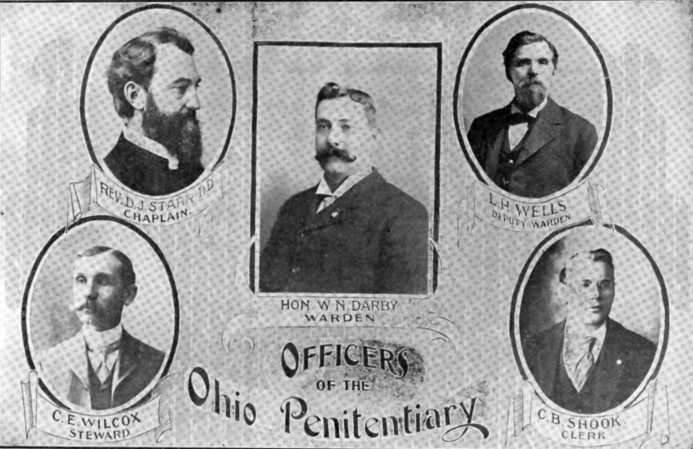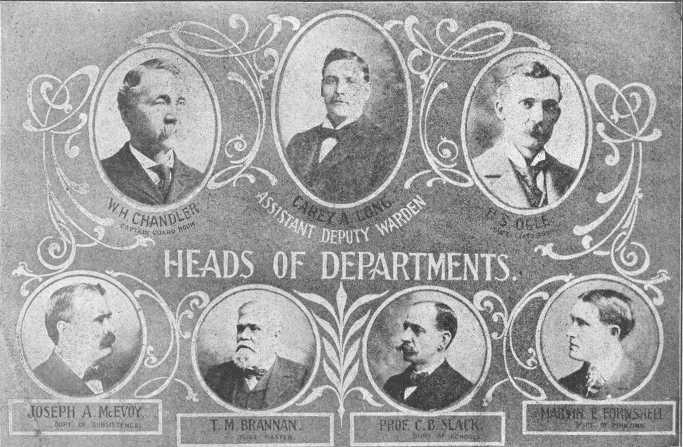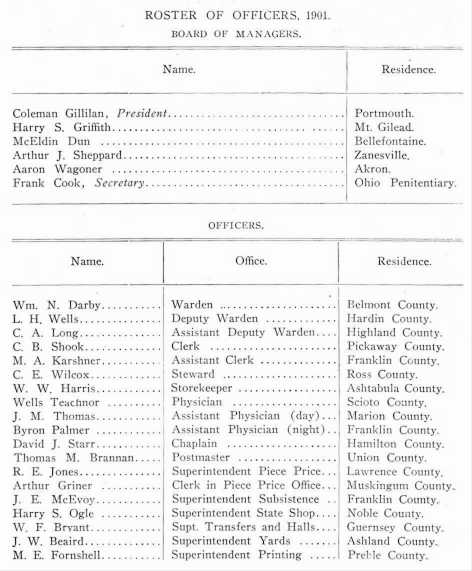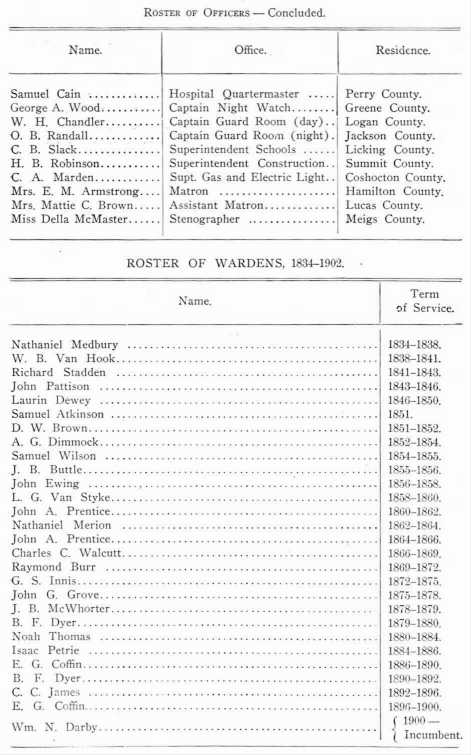|
THE Ohio Penitentiary covers 26 acres within the walls. About two acres outside the prison proper are occupied by offices, the Deputy Warden's residence, store rooms, barn and stables. The prison itself is walled on three sides, the fourth being wholly absorbed by sell houses, offices and the Warden's house. This side presents an imposing front, about 800 feet in length, on Spring street, facing the Scioto river, with the street and outer buildings between it and that stream, with a wide fringe of green lawn before it that in summer is beautified by parterres [ornamental garden areas] of flowers and shaded by fine trees. The cell houses and offices form a continuous building from the southeast to the southwest gate, in which are more than 1600 cells, about 600 of these being provided with beds for two inmates, the remainder being too small to receive more than one each. The Female Department, which abuts on the southeast gate, is somewhat advanced toward the street beyond the frontal line of the main prison, and reaches to the public sidewalk. It contains 46 cells.
The walls are dominated by towers at short distances apart and there are 11 of them. Within the enclosure is a small manufacturing city, comprising the shops of The Columbus Bolt Works, The George B. Sprague Cigar Co., C. S. Reynolds & Co., The E. B. Lanman Co., The P. Hayden Saddlery Hardware Co., The ohio Glove Co., The Columbus Chair Co., The National Broom Co., The Brown-Hinman & Huntington Co., and The Columbus Hollow Ware Co., all private corporations that contract with the state, through the Board of Managers, for the labor of prisoners, at specified prices for able-bodied and infirm men, respectively, and in many instances paying to the prisoners certain agreed amounts for all work produced beyond an appointed task. The total amount earned by such overwork and paid in to the account of the men who have earned it averages about $2500 per year. These contracts employ about 1100 prisoners. In addition to the labor utilized by these enterprises, the state employs about 800 men in the manufacture of the prisoners' clothing, the care of their sleeping quarters, repairs to buildings, the preparation of food, the management of the gas works—which supply gas to the State Blind Asylum and the State Deaf and Dumb Asylum, as well as to the Penitentiary—the care of the inside park and other grounds, and in the general administration of the mural city with its two thousand population. A tour of inspection more than repays the visitors, who come in great numbers that are increasing yearly, as the people realize more and more that an interesting development of modern ideas relative to the protection of society

Clockwise from center: Chaplain; Hon. W. N. Darby, Warden; L. H. Wells, Deputy Warden;
C. B. Shook, Clerk; C. E. Wilcox, Steward; Reb. D. J. Starr, D.D., Chaplain.
(Click on photo for enlarged version)
through the reformation of the criminal may be seen in its various phases from day to day. Here are sights that, once seen, well never be forgotten, as, for instance, the marching of the inmates to and from their meals, the shops and cells, in companies of military formation and martial step, gray clad and steady as veterans, each company officered by a guard. Since 1834, when the present prison was first occupied—or, rather, that rudimentary portion of it that is now known as the West Hall an army of more than 33,000 prisoners has passed through its portals, inward, and the men among whom, until a few years ago, wore the old regulation striped uniform of the convict. The striped clothing is used, on rare occasions, as a temporary garb of punishment in extreme cases of misconduct, and it is always effectual. The prisoner who has worn the stripes once rarely dons them for a second period of discipline.
The walled city has been swept by pestilence, once in its history. In 1849, the cholera raged here, and 121 prisoners died within twelve months. The bolts and bars bound them it the deadly embrace of the plague which, more dire in its work than the destroying angel of Egypt who claimed only the firstborn male, exacted the life of every third man among the prisoners. But it is now as healthy as a sanitarium. Remarkable to relate, the death rate has fallen from 55 to 36 in one year. The 55 deaths occurred during the year ending October 31, 1899; the 26 during the following fiscal year, embracing half of the first year of the present administration.
There is a finely appointed and well equipped hospital on the inside grounds, but it is more scantily inhabited than has been the case for years. Since the present administration has assumed control, the most important reform that has ever been introduced to the Penitentiary has been brought about, a long-needed innovation that has denuded the hospital of patients, halved the death rate and removed the source of a dangerous discontent. That improvement is a change in the dietary. While dietetic systems of the highest value have been scientifically developed and proved, as needful and in every sense economical, it remained for the present directorate of this great institution to adopt one and bring it to success. The food of the inmates is better in quality, more varied in kind, and prepared in a manner far superior to anything ever achieved or even attempted here before. For years, two thousand prisoners were served by cooking arrangements that were acknowledged to be but poorly adequate to prepare the plainest meal for 1300. But with the building of a rotary oven that has already paid for itself by the economy of its use, and a more varied cuisine at a trifling additional cost, per capita, this great result has been attained, showing to the taxpayer that economy and humanity go hand in hand. It has saved lives, th cost of medicine, the price of enforced idleness, the loss from poor work, funeral expenses,

Top l to r: W. H. Chandler, Captain Guard Room; Carey A. Long, Assistant Deputy Warden; H. S. Ogle, Supt. State Shop
Bottom l to r: Joseph A.McEvoy, Supt. Subsistence; T. M. Brannan, Post Master; Prof. C. B. Slack, Supt. of Schools; Marvin E. Fornshell, Supt. Printing
(Click on photo for enlarged version)
and no figures can tell of the vast improvement that it has brought about in the morals of the shut-in population. Reformation and slow starvation cannot go together. American people are accustomed to a rich and varied died, from childhood, and that which may be a luxury to the poor of some other country may be a neccesity to a man reared in Ohio. The fact that two-thirds of a meal was frequently thrown away at the Penitentiary, in former years, after two thousand hungry prisoners had rejected it, proves, beyond doubt, that it was not suitable for their use, and that such a meal was a waste of the taxpayers money.


|

